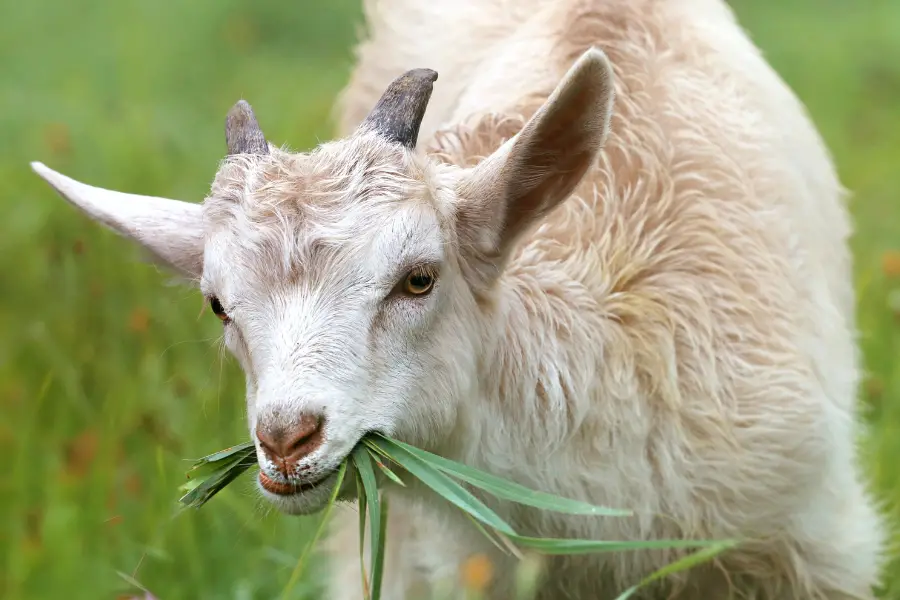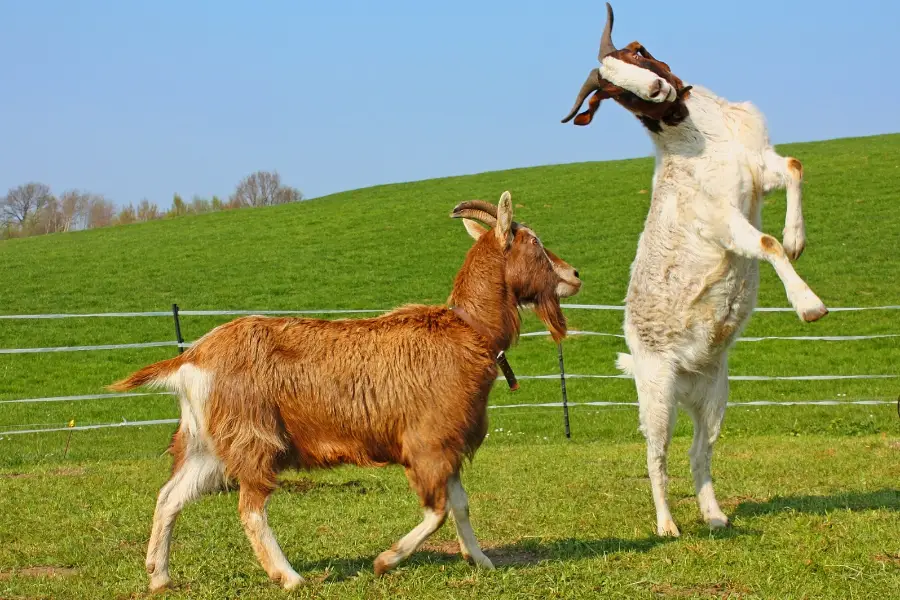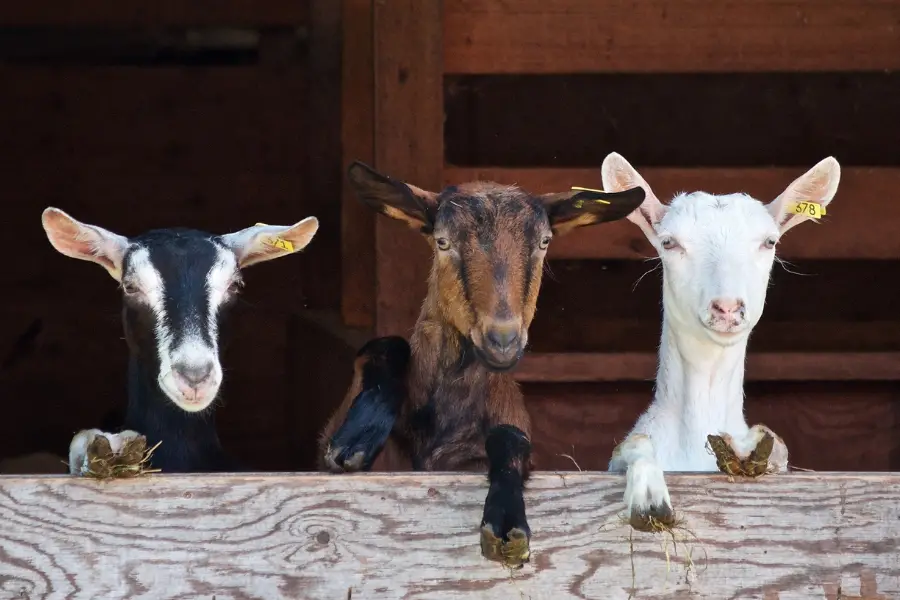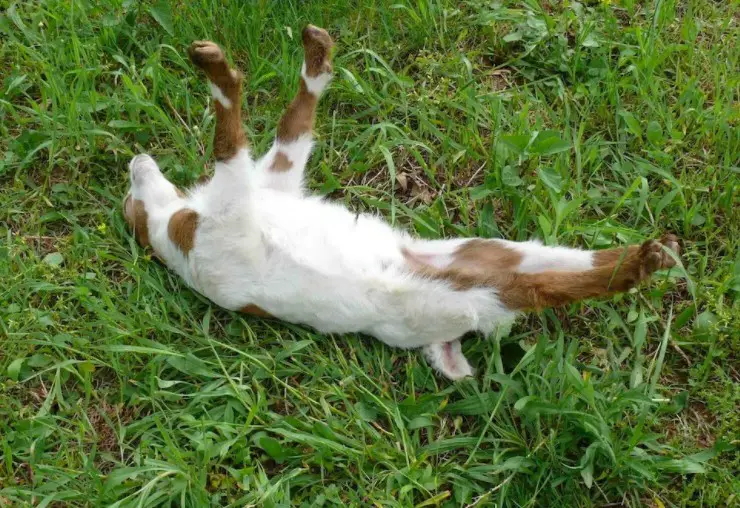
Credits to amusingplanet.com
Chances are, even if you don’t know anything about goats, you’ve heard of the famous Tennessee fainting goats.
Table of contents
- Fainting Goats are Myotonic Goats
- The Origin of Fainting Goats
- Fainting Goat Uses
- Fainting Goat Characteristics
- Raising Fainting Goats
- Breeding Fainting Goat
- Fainting Goat Prices
- Fainting Goat Breeders
- Fainting Goat Farming
- Raising fainting goats: Pros & Cons
- Fainting Goats Care: Top Tips
- Fainting goat associations: What are the Major Fainting Goat Associations in the USA?
- Fainting goats as pets: Do they make good pets?
These are the goats that are known around the world for their startling tendency to stiffen up and unexpectedly fall over, and have been the subject of many amusing videos on the internet.
But did you know that these goats are also popular meat goats, and easily farmed for profit?
Fainting Goats are Myotonic Goats
Fainting goats are also called myotonic goats because they have a genetic condition called myotonia. It’s a neuromuscular disorder, in which the skeletal muscles (used for movement) have a delayed ability to relax after being voluntarily contracted. They don’t actually faint (become unconscious) at all.
Myotonia only affects the muscles related to movement, which tense and lock in place, rendering the goats briefly paralyzed and often causing them to fall over. The symptoms of myotonia are more severe after idleness or relaxation, or when the body produces adrenaline, which is why it is associated with being startled.
So, while it’s common to think that these goats get so spooked that they faint, what actually happens is that their muscles are prone to sudden bouts of stiffness due to a delayed ability to relax.
Myotonia is a genetic condition, which is why it is concentrated in this particular breed of goat, but it does not affect their health or well-being, and they live otherwise normal and healthy lives, with a life span typical of other breeds of domestic goats.
The Origin of Fainting Goats

Fainting goats have a history as unusual as their surprising medical condition. In the 1880s, a traveling farm worker named John Tinsley arrived in Marshall County Tennessee with a herd of four unusual fainting goats.
It is believed that Tinsley himself came from Nova Scotia, but nobody knows where he found these unusual goats. He lived and worked on the farm of a Dr. H. H. Mayberry. After a year, John Tinsley moved on, and nobody knows what happened to him.
But he left these extraordinary goats (three does and a buck) with Dr. Mayberry. Dr. Mayberry realized that the condition was genetic, making this a distinct breed of goat that was, according to his research, unique in all the world.
Dr. Mayberry soon discovered some unexpected advantages to keeping fainting goats on his farm.
Firstly, myotonia causes increased overall muscle mass, making them good meat goats. Secondly, their condition makes them poor climbers, and therefore easier to contain in pasture than other goats. Finally, they were often kept with more desirable herd animals as a protection from predators.
Should a predator attack a herd of valuable sheep, the myotonic goat would become startled and fall down, making it easy prey and increasing the chances that the sheep would escape the predator.
Due to the practical usefulness of this breed, as well as because they are friendly and amusing, the breed slowly grew in popularity in Tennessee, and soon into neighboring states as well.
Despite an increase in interest in this unusual breed of goat, both for amusement and for their potential to be farmed for profit, myotonic goats remain very rare. There are only about 10,000 of these goats in the world, and they are classified as a threatened breed.
Fainting Goat Uses
Although fainting goats are classified as meat goats, they are seldom actually sold for meat. Their unusual characteristics and small numbers make them more valuable and profitable to breed and raise than to sell for slaughter. Myotonic goats are often used:
- As pets. Their ease of care and good nature make them attractive pets
- For research. Through study of myotonic goats, scientists and researchers have learned much more about myotonia congenita, a disorder that also affects humans.
- For amusement. Myotonic goats are easy to care for, and are of interest to friends and visitors. They are welcome animals on many farms, and provide hours of viral videos.
- For breeding. Their rarity makes these goats valuable, and it is actively being cultivated
Due to the value of these goats, they are not generally used as sacrificial animals to protect the herd any more, although it’s possible that a handful of people still use them in this way.
Fainting Goat Characteristics
Because fainting goats have only been bred for their myotonic condition, there is enormous variation in the acceptable characteristics of the breed. They have a wide variety of coats, ears, faces, and horns, and a large span of sizes.
Appearance
Fainting goats are most frequently black and white, but have variable coats and colors, and all are acceptable. The only unacceptable coat is hanging ringlets similar to the Angora coat.
Size
Fainting goats weigh 60-175 pounds, although some bucks can weigh as much as 200 pounds. They stand 17-25 inches high at the withers.
Production
Although classified as meat goats, fainting goats are not generally raised for meat, and there aren’t good production statistics for the breed.
Disposition
Fainting goats are docile and easy to handle, and are well-adapted to living with people.
Raising Fainting Goats
Fainting goats are landrace goats to the southern United States, and do best in that climate. They will need additional shelter and care if they are kept in much colder and wetter climates. However, their myotonia makes them much easier to care for than other breeds of goat.
Fainting Goat Social Needs
Like all goats, Fainting goats are herd animals and will not be healthy or happy when kept alone. If you are keeping a Fainting goat as a pet, they will often not do well in an environment where they are alone for extended periods. Keeping them with other goats, or even with grazing animals or dogs, will help satisfy the social needs of this outgoing little animal.
Fainting Goat Medical Needs
Like all goats, Fainting goats need periodic hoof trimming and deworming, depending on their diet and lifestyle. With myotonic goats, medical care is much easier, because they tend to stiffen and become immobile for ~20 seconds at a time when under stress. Many veterinarians would prefer to administer periodic vaccinations and hoof trimmings on a goat that holds still.
Fainting Goat Food Needs

Water
Goats should always have access to fresh, clean water. Remember that your fainting goats will need more water than usual in hot weather or when lactating.
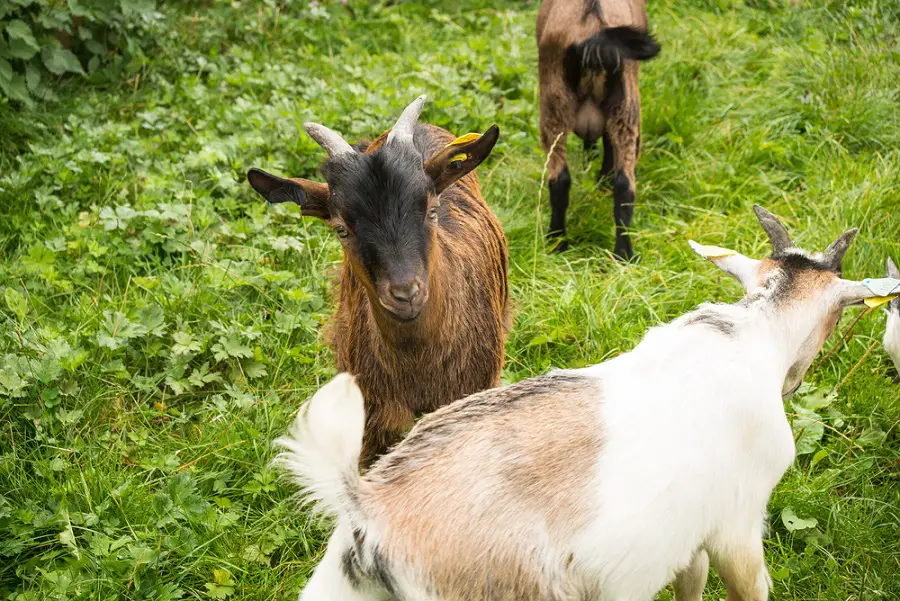
Forage and Feed
Fainting goats will happily browse on shrubs, weeds, herbs, and leaves. Allowing them freedom of pasture also gives them the exercise they need to stay healthy and prevent health problems.
Depending on the size of your pasture, the variety of plants available, and the season, alfalfa hay can and should be offered for free feeding. Purchase very high-quality hay for the healthiest goats and best quality milk for their fast-growing young.
Alfalfa hay is high in calcium, which is essential when goats are kidding and producing milk. Alfalfa hay can be expensive, so some people supplement other high-quality hay with alfalfa pellets instead. Grain is a desirable source of extra nutrition when a goat is producing milk, but is not strictly necessary.

Supplements
Depending on the plants in your pasture, local soil composition, and nutritional composition of your hay, it is likely that your goats will need mineral supplements. If you are providing high-quality food, they may only require small amounts of trace minerals.
When free-fed, goats will only eat as much mineral supplements as they need. Use a mineral supplement designed for goats or cattle, and avoid supplements designed for sheep, because goats and cows require copper, which is toxic to sheep. You can also feed your fainting goats fruit and vegetable scraps from the kitchen to add variety to their diet.
Fainting goat enclosure needs
Unlike other goats, fainting goats will not jump, due to their medical condition. They are reluctant to leave the ground, and will only jump about two feet high, and climb only on low, stable structures. Fencing is still required to protect them from predators, and to keep them from wandering away, and they will lean or occasionally chew on fencing.
A high-quality goat wire will withstand chewing and leaning, and generally exclude predators, depending on your local environment. Your fencing should not have openings larger than 4 x 4 inches, to prevent goats from sticking their heads through the fence to reach attractive weeds on the other side, and get their heads stuck.
Fainting goat shelter needs
All goats need shelter at night and in poor weather. Avoid situating the shelter on low ground that would accumulate rain. At minimum, the shelter can simply be a roof and three sides, so that goats can get out of bad weather.
It is better to have a dry dirt floor than a wood one; wood flooring can get slippery with mud or manure, and potentially injure a goat or cause foot problems. Does will need additional shelter and protection when they have kidded, and to be separate from the herd while the kids are still small.
Breeding Fainting Goat

Fainting does can come into heat when they are as young as 4 months, but breeding them that early should be avoided.
The rule of thumb is that a doe should not be bred until she is about 80% of her adult weight or at least 8 months old, but the wide range of adult weights in Fainting goats means that it’s safer to wait until she is a year old before allowing her to breed.
Does are polyestrous, and will breed all year long when exposed to a buck, and can breed again within 6 months of giving birth. Bucks are most fertile in late summer and early fall, and will noticeably go off feed when they are rutting.
When a doe is coming into heat, she will generally show signs with signature behaviors, such as:
- Tail Flagging
- Signs of mucous or discharge
- Swollen rear end
- More pronounced or unusual yelling or bleating
- If she is exposed to a buck, she will usually show greater interest in him and seek him out.
While most goat breeders prefer to observe a doe and be prepared to assist in kidding if necessary, and protect the doe and the kid(s) by isolating them, fainting goat does have a predilection for hiding their kids when possible, so they are often unnoticed in pasture for the first day or two.
It’s important to monitor when a doe has been bred and calculate 145-155 days to monitor the doe so she can safely kid. Fainting goats are excellent mothers, but it’s worth noting that they often have three kids, while the breed standard has only two teats. While this is generally not a problem, it’s good to keep an eye on multiple births and make sure the kids are adequately nursing.
Fainting goat wethers make excellent and popular pets, and this popularity as a pet helps to reduce some of the stress of figuring out what do to with the unneeded male kids born several times a year, and many breeders find it preferable to sell excess bucks as pets rather than as meat. It is also a good source of additional income from a fainting goat farm.
Fainting Goat Prices
Pedigreed fainting goat kids cost $300-$500, while unpedigreed goats cost about $200-$400. Wethers for sale as pets cost $50-$100.
Fainting Goat Breeders
These goats are extremely popular, and have become a common addition to petting zoos and farms that do business in public recreation. For that reason, it is easy to find fainting goat breeders with a simple search of the internet or social media.
For the best breeders and the animals with the best bloodlines, it is best to consult the breeder’s lists with the International Fainting Goat Association or the American Fainting Goat Association.
Fainting Goat Farming
Fainting, also known as the Tennessee Fainting goats, are an adorable, tiny, and unique breed. When they are overly excited or frightened, they faint. Not to worry, they don’t lose consciousness. Here’ a cute, little video of these goats fainting.
These goats faint because of a muscle condition called myotonia congenita that causes their legs to go stiff when they’re startled or excited. They go by many names.

Fainting goats can be traced back to Nova Scotia as early as the 1800s. They made their way to the US in the 1950s.
Fainting goats can weigh anywhere from 60 to 175 pounds.
Raising fainting goats: Pros & Cons
- Fainting goats are very easy to keep contained.
- They can easily adapt to most environments
- If paired with a Buck of the same size, the breeding process is very easy.
- For their small size, Fainting goats produce a high quantity of meat.
- Their meat is tender and full of flavor.
- They’re VERY family-friendly.
- Fainting goats are hard to come by
- They’re expensive due to their scarcity and high-quality meat.
- They’re easy prey for predators.
Fainting Goats Care: Top Tips
- It’s important that you’re making sure your fainting goats are getting their vaccanations as deemed by their vet.
- Of course, like most goats, these adorable creatures get very lonely if they’re kept alone.
- Fainting goats need to have their hooves trimmed frequently.
- They need more water when it’s in the hotter seasons and when they’re lactating.
- Plenty of open greens, shrubs, and hay will keep your faining goat happy.
Fainting goat associations: What are the Major Fainting Goat Associations in the USA?
- The International Fainting Goat Association
- The American Fainting Goat Organization
- The Myotonic Goat Registry
- The Fainting Goat Registry
Fainting goats as pets: Do they make good pets?
Fun fact: Bucks urinate on their beards as a way to mark their territory. In this article, Bob Phillips, a Knoxville Community Columnist, advises that you should only get a buck if you want to breed.
Fainting goats are adorable, enjoyable creatures that love companionship. They’re great for the whole family, and some people have even considered them the “new dog.” They’re less likely to escape like most breeds, and you don’t need any prior experience to have one. These traits, along with their desire to make friends, make them a perfect pet for the family.
Reference


